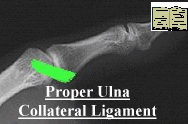Rupture Ulna collateral ligament - Skiers / Gamekeepers thumb
Rupture of Ulna Collateral Ligament (UCL) occurs by a hyper abduction force across MCP joint. Previously termed Gamekeepers thumb (should generally be reserved for chronic/ repetitive attrition injury of Ulna Collateral Ligament). New term for acute injuries skiers thumb as injury often occurs when thumb hyper abducted by ski poles.
Anatomy
MCPJ of thumb very mobile (diarthrodial hinged joint). Large variation in ROM.
Stability of MCPJ depends on:
- Joint capsule
- Volar plate,
- Collateral ligaments
 |
The proper UCL -
originates from the dorsal ulnar metacarpal head and
inserts into the volar ulnar base of the proximal
phalanx. Taught in flexion, relaxed in extension The accessory UCL - runs volar and parallel to the proper collateral ligament and inserts into the volar plate. Taught in extension, relaxed in flexion. |
Adductor pollicis provides dynamic stability to thumb resisting
abduction. It has 3 points of insertion: into the ulnar base of
the proximal phalanx, into the ulnar sesamoid, and into the
extensor expansion via the broad adductor aponeurosis.
The UCL normally avulses from the base of the proximal phalanx. The torn UCL stump folds back and comes to lie dorsal to the adductor aponeurosis and is prevented from healing to its anatomic insertion on the volar, ulnar base of the proximal phalanx. This forms the "Stener" lesion time.
Clinical
Presentation
- Pain
- Swelling, occasionally palpable swelling on ulna border "Stener" lesion
- Tenderness on the ulna side of the MCPJ
Stress testing if diagnosis in question. Analgesia via local or regional block (median and radial block at the wrist).
Remembering the UCL proper is taut in flexion and lax in extension, suggest perform stress test with 30 ° MCPJ flexion.
Positive
if: MCPJ angulates >35 °, or >15 ° of opposite
side. Important quality is end point of abduction (hard or soft).
Properly performed stress testing has eliminated the need for
stress radiographs in the majority of patient.
Radiographs
AP, Lateral - Look for bony fragment. Not all fragments at the base of the proximal phalanx represent avulsion of the UCL. They may be attached to the volar plate.
Ultrasound and magnetic resonance imaging (MRI) have been used to look for "Stener" lesion, but are not routinely indicated.
Treatment
Conservative
In the absence of a "Stener" lesion rupture of the UCL could be treated conservatively. However at present we have no reliable test to exclude interposition of the adductor aponeurosis. Therefore all acute ruptures of the UCL should be explored and treated operatively to avoid weakness/ instability of pinch grip.
Undisplaced or minimally displaced fractures with no joint instability could be managed non-operatively. Immobilize MCPJ leaving IPJ free for 4-6weeks.
Surgical
The aim is to reduce the ligament and allow healing. Surgical treatment for bony avulsions is recommended for those fractures with 2 mm or more of displacement, or significant articular involvement. Post op immobilize MCPJ leaving IPJ free. Protected movement MCPJ at 4 weeks, unprotected at 6 weeks, avoid strenuous pinch for 3 months.
Complications
- Stiffness
- Residual weakness / instability of pinch grip.
- Neuroma formation
Husband,
Jeffrey B. MD. McPherson, Scott A. MD. Bony Skier's Thumb
Injuries. Clinical Orthopaedics & Related Research.
(327):79-84, June 1996.